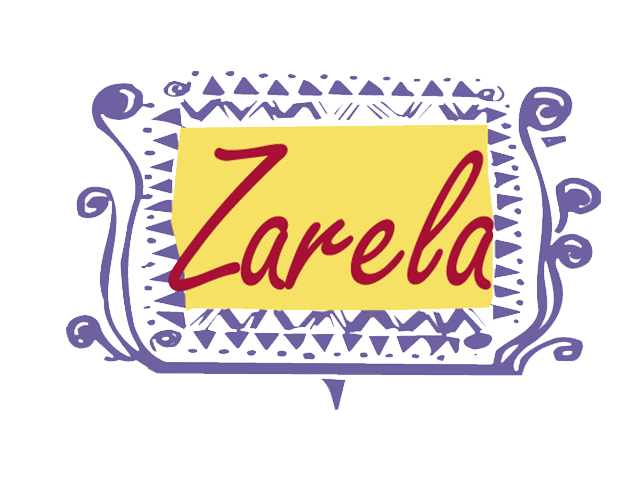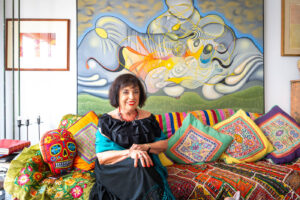When I was doing research for my book the Food and Life of Oaxaca, I happened to make a trip there in the winter and immediately went to the market. My first stop was my favorite counter where they sell all types of seasonal decorations. I’m greeted by the vision of my friend Dona Juana, the paper flower lady, surrounded by three rows of the Baby Jesus. The Christ Child comes in all sizes from six inches to two feet and is dressed in luxurious outfits, royal blue or turquoise velvet or satin overskirts, underskirts of cream or white lace or shiny taffeta, crowns of shiny paper or metal or garlands of small paper flowers. Hanging above where angels should be are bunches of miniature gold huaraches (sandals), tiny scepters, and cloth flowers marked “Made in China.” Her daughters and daughter-in-law are all busy sewing little garments. Dona Juana is consulting with a young couple holding a small undressed statue that they have brought with them. She quotes a price of 50,000 pesos (about $20) to dress their Baby Jesus in one of the little velvet numbers.
This shocks me. So much money for poor people to dress a doll, sacred or not? And I protest as soon as the couple goes away. Dona Juana says the market would bear her price and if someone cannot afford to pay, they get – or try to get – a madrina, literally a godmother, to help pay the expenses for their Baby Jesus. It’s important, it’s worth it. The new purchase will travel with them to church in two weeks — I can come back and see.
On Dona Juana’s advice I return to the church on February 2, Candlemas Day. It is filled to capacity and smells intensely of incense and candle wax. The aroma of wood smoke from hearths sticks to the clothes of everyone in the church. There are young and old couples, some wearing native dress of reds and shocking pinks, others in modern clothing and jewelry. The old ladies wrapped in heavy shawls in black and white patterns are widows — physically identical, each one indistinguishable from all the others except by the cut and quality of their clothing, precisely delineating each one’s tribal identity and economic class. The men mostly wear work clothes — jeans and boots with handloomed woollen tunics, or white muslin pants and sandals showing the cracked skin of worn feet.
Many people are carrying figures of the Christ child dressed as royally as the one the young couple took away from Dona Juana’s stand. Other people hold candles, many candles. All the men and some of the women carry baskets of various shapes and designs, some flat with a small trim, others deep and strong. All the baskets are decorated with tea towels, mostly embroidered and all freshly ironed. The contents are seeds — mixed together in one heap in some baskets, separated into different mounds in others. Some people have brought seeds of flowers and garden herbs, others vegetables, grain crops, and beans.
Candlemas celebrates the presentation of Christ at the temple by Joseph and Mary, as described in the Gospel of St. Luke. On that day the child was acclaimed by Simeon as God’s true light. So this is the day when people bring candles to the church to be blessed. They will be kept at home on the family altar. Every time a special favor is needed from God you light one of the candles — Dona Juana has told me to bring plenty — and say a prayer. This special meaning of the day I remember from my childhood. But the elaborately dressed figures are new to me. Here each family keeps a figure of the Baby Jesus on the home altar. On Candlemas Day they re-enact Jospeh and Mary’s visit to the temple by specially dressing their Christ child for the ceremonial presentation and bringing the little figure to be blessed.
The tradition of dressing religious images in special clothes is a powerful one in Mexico. The custom long vexed the Spanish religious authorities. In their climate of worship the image as it came from the sculptor or carver was supposed to be sufficicient as a help to inward thoughts. But for the Indians this added external adornment was necessary to put concrete personal claims on the divine object.
Several years ago, I went to a store in Brooklyn in January and was amazed to see stacks of clothes for the Baby Jesus on sale for the celebration so, this past weekend, I went to Sunset Park in Brooklyn to investigate if the tradition still lives on in this country. The first store we stopped in on 5th Avenue and 42 Street had a whole window full of Baby Jesus dressed to the nines and sitting in a gold chair. I inquired how much it cost to get a medium size statue. The grand total including gold chair, crown and sandals, satin dress and maybe a cape was $139.00 and they claimed to be doing brisk business.
Día de la Candelaria
(Día de las velas)
El Día de la Candelaria, como muchas otras celebraciones en México, representa una fusión de tradiciones prehispánicas y creencias católicas.
En México, el Día de la Candelaria se celebra el 2 de febrero. Es una celebración religiosa y familiar. En algunos lugares como Tlacotalpan, Veracruz, es un evento de mayor importancia que incluye desfiles y corrida de toros.
La fecha del 2 de febrero es 40 días después de la Navidad y los católicos la celebran como la Fiesta de la Purificación de la Santísima Vírgen o como la Presentación de Jesús en el Templo. De acuerdo a la ley judía una mujer que acababa de dar a luz sólo podía ir al templo a presentar al recién nacido hasta 40 días después del alumbramiento.
El origen de la palabra candelaria se deriva de las visitas que se hacían para llevar a los niños al Templo en la que se incluían cánticos con la frase “la luz de la revelación” por lo que se iban encendiendo velas que se bendecían posteriormente
El Día de la Candelaria está ligado al Día de Reyes, cuando los niños reciben regalos y las familias y amigos se reúnen a partir la Rosca de Reyes que tiene escondidas dentro del pan pequeñas figuras del niño Jesús. Según la costumbre, la persona que encuentra “al niño” en la rosca debe invitar a familiares y amigos a comer tamales y atole el día de la Candelaria.
Otra costumbre importante en México, que se manifiesta particularmente en los comunidades muy tradicionales, es tener una imagen del Niño Dios. En ocasiones, se designa un padrino del Niño Dios quien será responsable de organizar varias celebraciones entre la Navidad y la Candelaria. En la víspera de la Navidad se coloca al Niño en el Nacimiento, el Día de los Reyes se le traen regalos al Niño y el Día de la Candelaria se recoge el Nacimiento, se retira al Niño del pesebre y se viste con ropa especial para llevarlo a presentar al templo. Al final de esta ceremonia de la bendición del Niño es cuando se celebra la comida con los tamales.
Tradicionalmente se ha vestido al Niño con ropa elaborada especialmente de seda o encajes y huarachitos. Hay costureras especializadas en “vestir Niños Dioses” a las que los padrinos acuden. Sin embargo, la inventiva del pueblo mexicano es muy amplia y ha habido presentaciones de Niños Dioses vestidos, entre otros, con atuendos indígenas o de futbolista, lo cual ha sido muy celebrado por los feligreses del templo y se han colocado dichas imágenes en los altares de los templos que se visitan el 2 de febrero para bendecir al Niño.
<!– /* Style Definitions */ p.MsoNormal, li.MsoNormal, div.MsoNormal {mso-style-parent:””; margin:0in; margin-bottom:.0001pt; mso-pagination:widow-orphan; font-size:12.0pt; font-family:”Times New Roman”; mso-fareast-font-family:”Times New Roman”; mso-ansi-language:ES-MX;} @page Section1 {size:8.5in 11.0in; margin:1.0in 1.25in 1.0in 1.25in; mso-header-margin:.5in; mso-footer-margin:.5in; mso-paper-source:0;} div.Section1 {page:Section1;} –>


